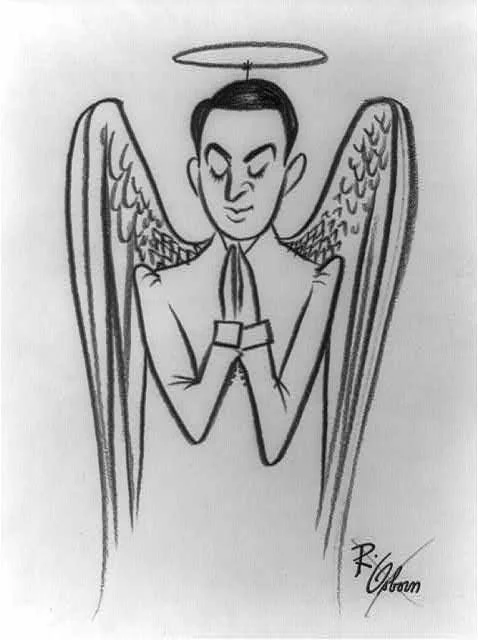The Dual Legacies of The Undead Roy Cohn
By Julia Smeaton
On January 6th, 2024, I walked the same downtown block, over and over again. A silver Rolls Royce slithered parallel to me. Each time, I snuck a glimpse into the backseat window. Once or twice, my gaze was momentarily returned by the shark-eyed stare of Roy Cohn. He looked through the glass at me: Straight from the face of actor Jeremy Strong. It was the three-year anniversary of the insurrection on the Capitol Building, and I was a background performer on Ali Abbasi’s upcoming movie The Apprentice, about the mentorship given to a young Donald Trump by notorious lawyer Roy Cohn. In the holding area between takes with my fellow extras, the only boy my age was spouting political opinions as period-accurate as the business suit and slicked-back bouffant he’d been costumed in. When I raised opposing views, he threw his hands up and said,
“Look, I’m Jewish, I’ve got lawyer genes built-in, I can argue with you for hours.”
I replied, “I’m Jewish too, let’s have at it.”
And we did. And I won. Riding a heady cocktail of victory and profound irony, I couldn’t help but ask him if he knew that the movie’s focus was perhaps the most notorious Jewish lawyer of all time. He did not. I explained with so much detail he jokingly asked if they’d given me the script.
“Of course not,” I said, “It’s all just everywhere.”
He was quick to disagree with that. But Trump certainly is everywhere– and in turn, so is Cohn, even nearly forty years after his death from AIDS.
In a 2019 CBC interview with Brent Bambury, filmmaker Matt Tyrnauer echoed this very observation, stating; "Roy Cohn seems to be everywhere in our hypocritical, apathetic society that has allowed a dangerous authoritarian man to rise to the most powerful seat in the world. And Roy Cohn was the person who really put him there. Because Trump is Roy Cohn. With the victory of Trump...Cohn goes from being a bold footnote to American history, to being a modern Machiavelli. He literally creates a president from beyond the grave”. Following the pair’s first connection in the elite Manhattan nightlife scene, Cohn provided Trump with legal counsel, mafia connections, and a playbook of social domination, refusal to admit sin, legal intimidation, and the art of financial crime.
In a 2020 article ‘My Roy Cohn, and Ours’, J. Hoberman (who refers to Cohn the “progenitor of the postmodern political world we now inhabit”), writes that “Trump proudly characterized Cohn as his ‘best friend’. Cohn introduced Trump to key mobsters, counselled him to always fight and never apologize, file suit and claim victory, taught him how to feed the press, and demonstrated the importance of a good tan” (Hoberman 2020). Since Trump’s rise to power, we have metaphorically dug Cohn back up for comparative analysis between the teacher and the protege– correlations that have been backed up by Cohn’s closest: “Cohn’s final lover, Peter Fraser, recently analyzed Trump’s mannerisms and noted that “that bravado, and if you say it aggressively and loudly enough…that’s the way Roy used to operate…and Donald was certainly his apprentice” (Sharp 2020). David L. Marcus, Cohn’s cousin, was quoted in 2019 as saying, “He didn’t just educate Trump, he didn’t just teach Trump, he put Trump in with people who would make Trump. Roy gave him the tools. All the tools.” In less than thirteen years of mentorship, Cohn passed down his place in American culture as a high-class demagogue in only less than 13 years of mentorship: Years that culminated in Trump’s abandonment of Cohn as his AIDS symptoms became unignorable. In the 2020 publication ‘Roy Cohn’s America: Conservatism, Sexual Politics’, and Memory in the 21st Century, Emily Sharp contends that by the time Cohn’s professed ‘liver cancer’ had progressed, “Trump was no longer just Cohn’s mentee, but his successor”.
Since the Trump administration, Cohn’s likeness has frequented the stage and screen more than ever before. Matt Tyrnauer’s 2019 documentary takes its title from an angered demand made by Trump in doubt of his law enforcement officials in 2018. When the ruthlessness of his legal counsel wasn’t appearing up to snuff, Trump is reported to have asked, “Where’s my Roy Cohn?” (Schmidt 2018). In 2018, Tony Kushner’s 1993 play Angels In America had a highly-awarded Broadway revival with Nathan Lane portraying a snarling, flamboyant, human villain in Cohn, kicking and screaming his way through his final weeks. In writing his characterization of Cohn, Kushner was inspired by Cohn’s 1988 panel on the AIDS Memorial Quilt, which read “Roy Cohn: Bully, Coward, Victim”.
This was also used as the title for a second documentary on Cohn– HBO’s Bully, Coward, Victim: The Story of Roy Cohn, released a year after Tyrnauer’s film and directed by Julius and Ethel Rosenberg’s granddaughter Ivy Meeropol, who emphasized the impact from her grandparent’s prosecutor that remains on her family. Cohn was depicted in the historical fiction series Fellow Travelers, which followed two gay men in the US Senate from the Red Scare of the 1950s all the way to the AIDS crisis. It aired its final episode on December 17, 2023, the same night that a recent Toronto production of Angels In America ended its run at Buddies In Bad Times Theatre, which featured Canadian actor Jim Mezon as Cohn. With Ali Abbassi’s film on the horizon, and with a release likely lining up with election season, Cohn isn’t going anywhere. Reminiscent of his character in Angels In America, where he plays dead like a child for shits and giggles and pops back up in scenes long after his onstage death in afterlife asides and in the visions of his fictional protege Joe Pitt, Cohn remains a sort of jack-in-the box of the undead. It is clear that our contemporary artists have been raised alongside the rest of us in a haunted house; and are grappling with the ghost of Cohn in the ways they best know how.
Cohn’s status as a spectral figure was seemingly destined from the beginning. An illustration from June 1954 in a publication following the Army-McCarthy hearings dissecting Cohn’s variegated public images: The original New Republic article titled "Trial by Television: The Two Roy Cohns" referred to his two personas as the “Boy Rasputin” and the “Young Crusader”. In the article, satirist Robert Chelsey Osborn portrayed 27-year-old Cohn as a winged angel in contented prayer.
This depiction of Cohn as an angel is eerie, knowing of how interconnected Roy’s image would come to be with Angels In America, in which the titular Angel preaches the same anti-migratory policy and racism that would become a hallmark of the Trump administration (Grady 2018). Yet as Osborn’s Angel Roy, Cohn is the butt of a joke. Published a year post-Rosenberg trial– an important step in Roy aligning himself with the WASP, staunchly (if not performatively) heterosexual powers of the era— the image of him is crucially lathered in Christian imagery. Yet he is illustrated with exaggerated features that recall stereotypical antisemitic images of the miserly Jew, drawing an intriguing contrast through the depiction. Additionally, both Tyrnauer and Meeropol’s documentaries depict him being alluded to as a ‘fairy’ by Joseph Welch in the Army-McCarthy hearings. These examples serve as evidence that despite outwitting and outperforming his competitors and peers, Cohn never could quite escape his ‘otherness’, not in life nor death. This otherness— his homosexuality and Judaism, and his almost biblical rejection of both– has contributed significantly to the endurance of his legacy.
Writing for The Atlantic in 2020, Sophie Gilbert emphasized Cohn’s “naked venality, the emotionless gaze, the hypocrisy and latent self-hatred. Cohn was a homophobic gay man and a Jew who persecuted other Jews during the anti-communist witch hunts of the fifties”. The intrigue from creatives whose identities intersect with his, namely Tony Kusher, is something I relate to. In the 2018 book The World Only Spins Forward: The Ascent of Angels In America, founder of the AIDS Memorial Quilt Cleve Jones states of Kushner, “For a gay Jewish man to completely re-appropriate Roy Cohn’s story, to tell this larger story about the AIDS crisis in the 1980s, is really incredible. To have a gay man who is also a Jew wrestling with the legacies of shame and hypocrisy among his own people, on his own terms, is really powerful.”
Just as he had two personas in youth with the Crusader and the Rasputin, Cohn has dual legacies. The art produced in his wake and the analyses about them are Cohn’s cultural legacy. His political legacy takes a human form in Trump, and manifests in immeasurable consequences. In her 2020 publication for Esquire, Adrienne Westenfeld calls this “the moral rot of American conservatism, evoked so vividly in [Angels In America], whose longtime sins have come home to roost. In the epilogue of the play, Prior famously says, “The world only spins forward.” Today, it feels as if the world is spinning backwards, with conservative lawmakers fighting to turn back the clock on civil rights, rolling back environmental regulations, and assaulting constitutional norms. To read Angels in America on the eve of the 2020 election is to see the Reaganite vision of the future realized, with startling, frightening clarity” (Westenfeld 2020).
More than Westenfeld likely ever imagined has been rolled back in the US and beyond since her article was published. The censorship, oppression, denial, and fascism of the century that Roy Cohn was born and died in remain in a turning cycle. The world is still spinning forwards, and it only takes a touch of menschlichkeit and a glance back at recent history to realize what we are spinning towards. Once the recognition occurs and the connections are made, we may find responses, if not answers, to the innumerable fear-fuelled questions that are yelled into the void on the daily. I leave with one response to one such question that still hangs in the air, six years later– Where is your Roy Cohn, Mr. Trump?
I say: Where isn’t he?
Bibliography
Schmidt, Michael S. “Obstruction Inquiry Shows Trump’s Struggle to Keep Grip on Russia Investigation.” The New York Times, The New York Times, 5 Jan. 2018, www.nytimes.com/2018/01/04/us/politics/trump-sessions-russia-mcgahn.html.
Krouse, Michael. “The Final Lesson Donald Trump Never Learned from Roy Cohn - Politico ...” Politico Magazine, 19 Sept. 2019, www.politico.com/magazine/story/2019/09/19/roy-cohn-donald-trump-documentary-228144/.
Bambury, Brent. “‘He Created a President from beyond the Grave’: How Roy Cohn Created the Blueprint for Donald Trump | CBC Radio.” CBC News, CBC/Radio Canada, 20 Sept. 2019, www.cbc.ca/radio/day6/trudeau-s-blackface-vaping-related-illness-irrational-voters-rambo-tourism-roy-cohn-and-more-1.5288549/he-created-a-president-from-beyond-the-grave-how-roy-cohn-created-the-blueprint-for-donald-trump-1.5288555
Westenfeld, Adrienne. “Angels in America Draws a Clear Line between Donald Trump and Roy Cohn.” Angels in America Remains a Vivid Portrait of the Forces That Created Donald Trump, Esquire, 8 Oct. 2020, www.esquire.com/entertainment/books/a34314017/angels-in-america-roy-cohn-donald-trump-covid-2020/.
Grady, Constance. “How 2018 Reshaped Angels in America.” Vox, Vox, 30 Apr. 2018, www.vox.com/culture/2018/4/30/17199540/angels-in-america-2018-broadway-nyc-tony-kushner
Gilbert, Sophie. “HBO’s Roy Cohn Documentary Is a Lesson for Trump.” The Atlantic, Atlantic Media Company, 18 June 2020, www.theatlantic.com/culture/archive/2020/06/hbo-roy-cohn-documentary-lesson-trump/613198/.
Hoberman, J. “My Roy Cohn, and Ours.” Tablet Magazine, 18 June 2020, www.tabletmag.com/sections/arts-letters/articles/roy-cohn.
Sharp, Emily. 2020. “Roy Cohn’s America: Conservatism, Sexual Politics, and Memory in the 21st Century.” The Macksey Journal 1 (1). https://mackseyjournal.scholasticahq.com/article/21806-roy-cohn-s-america-conservatism-sexual-politics-and-memory-in-the-21st-century
Creator: Unknown. AIDS Quilt Panel, “Roy Cohn: Bully, Coward, Victim”. The Dallas Metroplex Chapter of the Names Project Foundation Collection (AR0765), University of North Texas Special Collections, 1988, https://digital.library.unt.edu/ark:/67531/metadc953511/
Osborn, Robert Chesley. Illustration titled “Roy Cohn”, "Trial by Television-V: The Two Roy Cohns". The New Republic, June 14, 1954. Caroline and Erwin Swann collection of caricature & cartoon. Library of Congress Prints and Photographs Division Washington, D.C. 20540 USA https://www.loc.gov/item/2009617112/

